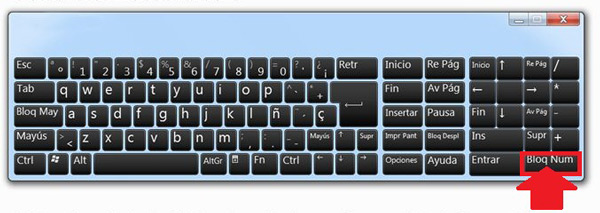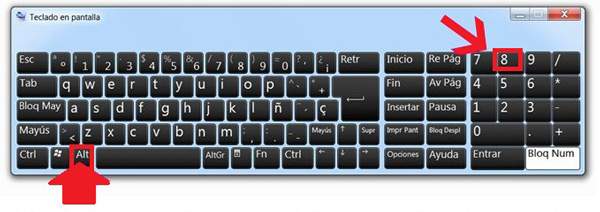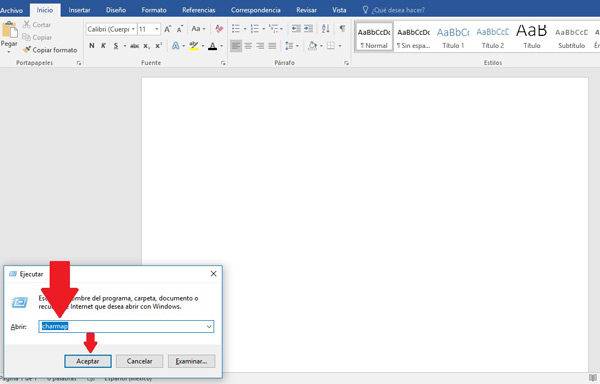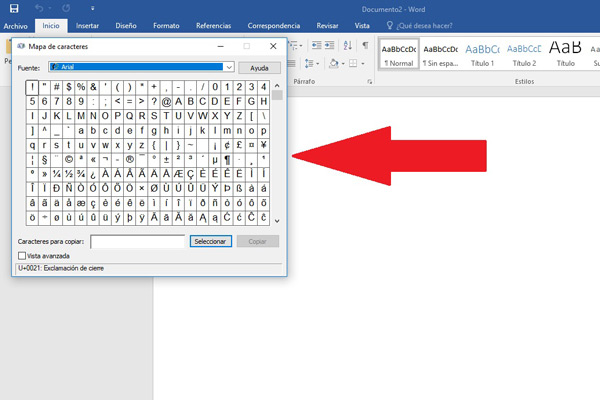
Index:
UPDATED ✅ Do you need to know what they are and how to use all the special characters on the keyboard? ⭐ ENTER HERE ⭐ and discover everything about it ✅ EASY and FAST ✅
special characters have become a very important tool for most users, especially when we make use of the Microsoft Office suite programs. Whether preparing a project in Word or Excel and we need to make use of them.
Usually these characters not usually displayed on the computer keyboardbut they are hidden and to be shown it must be done under a key combination. The key is mostly used. “Alt + the number pad”, whether to show signs, symbols, letters, numbersamong other characters.
If you are looking to create some type of document and you need to apply some characters to it, such as greek letters, currency symbols, among others. So here we are going to explain what they are, what they are for and how they can be inserted all these elements on your PC.
What are the special characters on my computer keyboard?
Special characters can be signs, numbers, letters, symbols, figures of the different world currencies, among many others. All of them may be needed at some point in our lives, whether when we are preparing a project or document with a specific program.
As already mentioned above, these not usually found on the keyboardthat is, they do not appear on a specific key, but we must use a button combination for them to appear on the screen. Furthermore, it is important to mention that they classified according to the language usedwhere each of them varies a little.
In this way, all this coding system ends up being used because text files are made up of characters. This allows them to be represented by the system and in this way the team is able to assimilate them and display them on the screen.
How are these characters classified? Main coding systems
In the case of character encoding will depend mainly on the different modes of the language used. This means that this will vary depending on the language used. All this needs to be represented in the correct way so that these coding systems can be translated correctly and thus be assimilated by the team.
All this is usually classified as follows:
ASCII system
East ascii system is the abbreviation of “Standard American Code for Information Exchange.” This system is mainly based on the latin alphabet and is currently made up of 128 characterswhere only 95 of them are printable.
All this was created for the year 1963 in the English languagethis began to create many limitations for its use in other languages, since its use is difficult to be able to represent characters and symbols that were required.
This type of encoding is made up of all the letters of the alphabet and the numbers from 0 to 9, as well as some special symbols. Among some of the printable characters that we can find in ASCII we have the following:
- ! ” # $ % & ‘ ( ) * +, -. / 0 1 2 3 4 5 6 7 8 9 :;= ? @ ABCDEFGHIJKLMNOPQRSTU VWXYZ [ ] ^ _ ` abcdefghijklmnopqrstu vwxyz { | } ~
ISO-8859-1 system
We also find ISO-8859-1, which was created mainly to be able to supply all those needs that ASCII was not able, since he had some limitationsespecially that of the language that largely affected its use in Latin America.
Bearing this in mind, ISO-8859-1, It is mainly used for the regions of Western Europe, Latin America and North America. Since it became a more practical tool, it uses 8 bits that allows provide some additional characters that were not used in the English language. These were the accents, the letter ñ, among many others.
unicode
we finally found the unicode system. As in the previous case, this was created to finish completing what ASCII and ISO were not able to achieve. As we mentioned before, ISO was available for different geographic regions. Nevertheless, the 8 bits they offered they were not able to encode all the alphabet used in the worldso it ended up being quite short before the demands.
Therefore, as a solution to all these problems, it is created Unicode and a Universal Character Set (UCS) ISO/IEC 10646. All this ends up assigning a unique code to the more than fifty thousand existing symbolswhich allowed the use of a increased number of text characters and symbol encoding of different languages. Some of the symbols that can be inserted with Unicode encoding are the following: ☂,❀,✰,☠
Steps to learn how to insert each special character on my computer
There are two ways to insert letters and special signs on the computer, this can be through the buttons “Alt + a number” or through characters map. To do this, you will simply have to execute the steps that we are going to explain below:
With Alt and the numeric keypad
The first method that we present to you is about using keyboard button combination and is commonly used in windows computers. In order to insert them you need to follow these steps:
- The first thing is to make sure that the numeric keypad is on, this is almost always on the right side of your keyboard. To activate them you must press the key “Bloq NUM”, Keep in mind that you must first make sure that it is deactivated, otherwise by pressing said button we deactivate it.

- Once the numbers have been activated, the next thing to do is to press the button “Alt” and not let go.
- Having “Alt” pressed now click on the number keys we need “8” and immediately we release the key “Alt”.

- It will automatically appear symbol or character that you have requested with the previous action.
Through this process you can begin to insert various characters, symbols and signs in your different documents.
With character map
The character map is a program that comes integrated in the windows operating system and is available for various versions 7, 8 and 10. It allows you to see all the elements that are available in the selected work source.
In this way, this has become in another of the available methods to be able to insert letters, symbols and special signs. In order to execute this, you will need to perform these steps:
- To start it you must go to the box “Run” or of “Start”, you can also access it by pressing the key “Windows + R”.
- When the window appears “Run” on the screen write the following “charmap” and click on “To accept” or press “Enter”.

- A window will then appear where you can select those symbols what do you need and copy it to the clipboard. This way you can paste it in the program you need it.

Note that through this map you also have the opportunity to use those symbols that have been created with “Private character editor”.
List of all codes for inserting special characters using the ALT key and the numeric keypad
One of the easiest and fastest ways to insert any sign, symbol or letter is through the button combination “Alt + number”. However, in order to use this method, it is necessary to know what are the sequences and what results will each of them give us.
It is important that you bear in mind that each of the sequences that we are going to explain in the following table are only available for the Windows operating system. Thus, here we present the following tables with their combinations of keys and character.
| ALT + | Character | ALT + | Character | ALT + | Character | ALT + | Character |
| 1 | ☺ | 51 | 3 | 101 | and | 151 | or |
| two | ☻ | 52 | 4 | 102 | F | 152 | Y |
| 3 | ♥ | 53 | 5 | 103 | g | 153 | EITHER |
| 4 | ♦ | 54 | 6 | 104 | h | 154 | OR |
| 5 | ♣ | 55 | 7 | 105 | Yo | 155 | ¢ |
| 6 | ♠ | 56 | 8 | 106 | j | 156 | £ |
| 7 | • | 57 | 9 | 107 | k | 157 | ¥ |
| 8 | ◘ | 58 | : | 108 | he | 158 | ₧ |
| 9 | ○ | 59 | ; | 109 | m | 159 | ƒ |
| 10 | ◙ | 60 | 110 | n | 160 | a | |
| eleven | ♀ | 61 | = | 111 | either | 161 | Yo |
| 12 | ♂ | 62 | > | 112 | p | 162 | either |
| 13 | ♪ | 63 | ? | 113 | what | 163 | or |
| 14 | ♫ | 64 | @ | 114 | r | 164 | ñ |
| fifteen | ☼ | 65 | A | 115 | s | 165 | Ñ |
| 16 | ► | 66 | B. | 116 | you | 166 | th |
| 17 | ◄ | 67 | C | 117 | or | 167 | º |
| 18 | ↕ | 68 | D | 118 | v | 168 | do |
| 19 | ¶ | 69 | AND | 119 | w | 169 | ⌐ |
| twenty | ¶ | 70 | F | 120 | x | 170 | ¬ |
| twenty-one | § | 71 | G | 121 | Y | 171 | ½ |
| 22 | ▬ | 72 | H | 122 | z | 172 | ¼ |
| 23 | ↨ | 73 | Yo | 123 | { | 173 | ¡ |
| 24 | ↑ | 74 | J | 124 | | | 174 | « |
| 25 | ↓ | 75 | K | 125 | } | 175 | » |
| 26 | → | 76 | L | 126 | ~ | 176 | ░ |
| 27 | ← | 77 | M | 127 | Δ | 177 | ▒ |
| 28 | ∟ | 78 | N | 128 | Ç | 178 | ▓ |
| 29 | ↔ | 79 | EITHER | 129 | or | 179 | │ |
| 30 | ▲ | 80 | P | 130 | and | 180 | ┤ |
| 31 | ▼ | 81 | Q | 131 | a | 181 | ╡ |
| 32 | “space” | 82 | R | 132 | a | 182 | ╢ |
| 33 | A | 83 | yes | 133 | a | 183 | ╖ |
| 3. 4 | « | 84 | T | 134 | a | 184 | ╕ |
| 35 | # | 85 | OR | 135 | ç | 185 | ╣ |
| 36 | $ | 86 | v | 136 | and | 186 | ║ |
| 37 | % | 87 | W | 137 | and | 187 | ╗ |
| 38 | & | 88 | X | 138 | and | 188 | ╝ |
| 39 | ‘ | 89 | Y | 139 | Yo | 189 | ╜ |
| 40 | ( | 90 | Z | 140 | Yo | 190 | ╛ |
| 41 | ) | 91 | [ | 141 | ì | 191 | ┐ |
| 42 | * | 92 | 142 | Ä | 192 | └ | |
| 43 | + | 93 | ] | 143 | A | 193 | ┴ |
| 44 | , | 94 | ^ | 144 | AND | 194 | ┬ |
| Four. Five | – | 95 | _ | 145 | æ | 195 | ├ |
| 46 | . | 96 | ` | 146 | Æ | 196 | ─ |
| 47 | / | 97 | a | 147 | either | 197 | ┼ |
| 48 | 98 | b | 148 | either | 198 | ╞ | |
| 49 | 1 | 99 | c | 149 | either | 199 | ╟ |
| fifty | two | 100 | d | 150 | or | 200 | ╚ |
| ALT + | Character | ALT + | Character | ALT + | Character | ALT + | Character |
| 201 | ╔ | 251 | √ | 178 | ² | 228 | a |
| 202 | ╩ | 252 | ⁿ | 179 | ³ | 229 | a |
| 203 | ╦ | 253 | ² | 180 | ´ | 230 | æ |
| 204 | ╠ | 254 | ■ | 181 | µ | 231 | ç |
| 205 | ═ | 255 | “space” | 182 | ¶ | 232 | and |
| 206 | ╬ | 128 | € | 183 | · | 233 | and |
| 207 | ╧ | 130 | ‚ | 184 | ¸ | 2. 3. 4 | and |
| 208 | ╨ | 131 | ƒ | 185 | ¹ | 235 | and |
| 209 | ╤ | 132 | „ | 186 | º | 236 | Yo |
| 210 | ╥ | 133 | … | 187 | » | 237 | Yo |
| 211 | ╙ | 134 | † | 188 | ¼ | 238 | Yo |
| 212 | ╘ | 135 | ‡ | 189 | ½ | 239 | Yo |
| 213 | ╒ | 136 | ˆ | 190 | ¾ | 240 | ð |
| 214 | ╓ | 137 | ‰ | 191 | do | 241 | ñ |
| 215 | ╫ | 138 | Š | 192 | A | 242 | either |
| 216 | ╪ | 139 | ‹ | 193 | A | 243 | either |
| 217 | ┘ | 140 | o | 194 | A | 244 | either |
| 218 | ┌ | 142 | Ž | 195 | A | 245 | either |
| 219 | █ | 145 | ‘ | 196 | A | 246 | either |
| 220 | ▄ | 146 | ‘ | 197 | A | 247 | ÷ |
| 221 | ▌ | 147 | “ | 198 | Æ | 248 | either |
| 222 | ▐ | 148 | ” | 199 | Ç | 249 | or |
| 223 | ▀ | 149 | • | 200 | AND | 250 | or |
| 224 | α | 150 | – | 201 | AND | 251 | or |
| 225 | H.H | 151 | — | 202 | AND | 252 | or |
| 226 | Γ | 152 | ˜ | 203 | AND | 253 | Y |
| 227 | π | 153 | ™ | 204 | YO | 254 | þ |
| 228 | Σ | 154 | š | 205 | YO | 255 | Y |
| 229 | σ | 155 | › | 206 | YO | ||
| 230 | µ | 156 | – | 207 | YO | ||
| 231 | τ | 158 | ž | 208 | Ð | ||
| 232 | Φ | 159 | Y | 209 | Ñ | ||
| 233 | Θ | 160 | 210 | EITHER | |||
| 2. 3. 4 | Ω | 161 | ¡ | 211 | EITHER | ||
| 235 | δ | 162 | ¢ | 212 | EITHER | ||
| 236 | ∞ | 163 | £ | 213 | EITHER | ||
| 237 | φ | 164 | ¤ | 214 | EITHER | ||
| 238 | ε | 165 | ¥ | 215 | × | ||
| 239 | ∩ | 166 | ¦ | 216 | EITHER | ||
| 240 | ≡ | 167 | § | 217 | OR | ||
| 241 | ± | 168 | ¨ | 218 | OR | ||
| 242 | ≥ | 169 | © | 219 | OR | ||
| 243 | ≤ | 170 | th | 220 | OR | ||
| 244 | ⌠ | 171 | « | 221 | Y | ||
| 245 | ⌡ | 172 | ¬ | 222 | Þ | ||
| 246 | ÷ | 173 | 223 | H.H | |||
| 247 | ≈ | 174 | ® | 224 | a | ||
| 248 | ° | 175 | ¯ | 225 | a | ||
| 249 | ∙ | 176 | ° | 226 | a | ||
| 250 | · | 177 | ± | 227 | a |
Computing